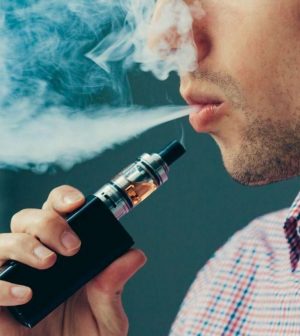- Navigating Your Midlife Crisis: Embracing New Possibilities
- City Raccoons Showing Signs of Domestication
- Mapping the Exposome: Science Broadens Focus to Environmental Disease Triggers
- One Week Less on Social Media Linked to Better Mental Health
- Your Brain Changes in Stages as You Age, Study Finds
- Some Suicide Victims Show No Typical Warning Signs, Study Finds
- ByHeart Formula Faces Lawsuits After Babies Sickened With Botulism
- Switch to Vegan Diet Could Cut Your Greenhouse Gas Emissions in Half
- Regular Bedtime Does Wonders for Blood Pressure
- Dining Alone Could Mean Worse Nutrition for Seniors
Vaping Just Once Triggers Dangerous ‘Oxidative Stress’

Young, healthy adults who try vaping for the first time may experience an immediate reaction that can harm cells and lay the groundwork for disease, according to a new study.
Just 30 minutes of vaping can increase oxidative stress, which occurs when there is an imbalance between free radicals (molecules that damage cells) and antioxidants that fight them, researchers said.
“Just like there is no safe level of tobacco cigarette smoking, there is no safe level of electronic cigarette vaping — vapes are not harmless, and nonsmokers should not use them,” said lead researcher Dr. Holly Middlekauff, a professor of cardiology and physiology at the University of California, Los Angeles David Geffen School of Medicine.
“Many young people — up to 20% to 30% of high school students — have vaped in the last month, thinking that vapes are harmless,” she said. “This misperception is fueled by the dessert flavors and the cool dispensing devices that characterize vapes.”
But this new research shows that even one vaping session can cause detectable adverse effects on the body, Middlekauff said.
Although participants in this study were young adults, Middlekauff suspects that results in teenagers would be the same.
“Over time, recurrent increases in oxidative stress may take their toll, increasing risk of cardiovascular and pulmonary diseases, cancer and accelerated aging,” she said.
For the study, Middlekauff and her colleagues collected participants’ immune cells before and after 30 minutes of vaping and compared changes in oxidative stress among three groups. Researchers also repeated the process in a 30-minute session of “sham vaping,” or puffing on an empty straw.
Participants included 32 people between 21 and 33 years of age: 11 nonsmokers, 9 smokers of regular cigarettes and 12 e-cigarette users.
Among nonsmokers, oxidative stress levels were two to four times higher after vaping than before, the study found.
The same vaping exposure, however, did not increase oxidative stress in regular cigarette and e-cigarette smokers. Researchers said that’s probably because their levels were already elevated.
The findings were published online Aug. 9 in JAMA Pediatrics.
The authors said their results are troubling because the popularity of vaping continues to grow among teens and young adults. Nearly 30% of high school students in a 2020 study said they had used an e-cigarette during the previous month.
Patricia Folan, director of the Center for Tobacco Control at Northwell Health in Great Neck, N.Y., was not part of the study but reviewed the findings. She said health experts have known for some time about the health harms of vaping.
“The perception that e-cigarette products and the vapor produced by them is a healthy alternative to cigarette smoking was generated by the manufacturers of these products,” Folan said. “As more people, particularly young people, have been using e-cigarettes, we have learned about their capacity for addiction and the harm caused by nicotine addiction to the developing adolescent brain.”
The products contain toxins and cancer-causing substances and have been associated with health hazards such as vaping-related lung injuries, she said.
“The aerosol often irritates the throat, eyes and lungs,” Folan said, adding that recent studies have also shown that vaping can increase the risk for developing serious COVID-19 infections.
“Public health education about these and other findings may help to reverse the popularity of e-cigarettes fostered by advertising and social media influencers,” Folan said. Counseling from pediatricians and other health care providers is needed, she added.
“For those unwilling to quit, education about tobacco-free and vape-free indoor environments should be strongly encouraged to avoid exposure to these unsafe products,” Folan said.
More information
For more about the health consequences of vaping, visit the U.S. Centers for Disease Control and Prevention.
SOURCES: Holly Middlekauff, MD, professor, cardiology and physiology, UCLA David Geffen School of Medicine, Los Angeles; Patricia Folan, DNP, RN, director, Center for Tobacco Control, Northwell Health, Great Neck, N.Y., JAMA Pediatrics, online, Aug. 9, 2021
Source: HealthDay
Copyright © 2025 HealthDay. All rights reserved.










